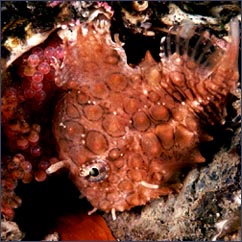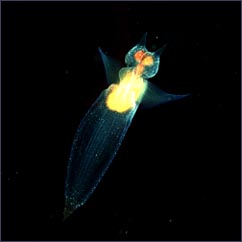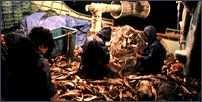
|
No. 20 The Frozen Sea: The Creatures of Raosu. |

|
No. 20 The Frozen Sea: The Creatures of Raosu. |

In the middle of a cliff, a male "idodango" guards his spawns. Within the eggs, the fries look outward and await their day of incubation. |

In the water where the temperature is below freezing, a clione is moving his fins gracefully and is being carried by the flow of the sea. "The Angel of the Ice Floes" is an apt name for this figure. |
|
At long last, the weather has turned spring like. Speaking of
mid-March, it is the time when the frozen ice of the Sea of Okhotsk,
breaks up and detaches from the coast. The sea bottom under the ice
floe is quite interesting. It was 17 to 18 years ago that I first dived
into this sea. The severity of the environment was far worse than
anything I had expected. Nevertheless, the sea bottom, which is rarely
seen because of this severity, was a treasure-trove of discoveries.
I remember that I laughed with my friends after the dive, because of our ungainly forms as we crawled on the beach with icicles hanging from our faces. The answer to the question "Why go through such hardship to dive into the frigid sea?", was becoming clearer. It was to get one look at the personality and charm of the creatures living in the frozen sea bottom. The seas surrounding Raosu, a town in the south eastern part of the Shiretoko Peninsula, is the best place to meet the charming creatures of the northern sea. There are countless fascinating creatures which I have encountered in this sea. Let me introduce you to some of them. First, there is the "idodango". It is a fish about the size of a golf ball. Its berry fin is like a suction cup so the "idodango" can attach itself anywhere. As I dived into the dark sea from the crevice of an ice floe, in the middle of a sheer cliff about 8 meters below the surface, a male "idodango" was keeping its eggs safe. I have once seen what may have been an actual spawning of the "idodango ". On the rocky sea bed about 30 meters down, an "idodango" couple was closing in as in a dance. But as I pointed my camera lights at them, I must have broken their feverish spell and they separated. I played the inelegant role of being the one to upset their romantic mood. The spawning process is a follows. The couple closes in and spawns on the seabed. The male guards and protects the eggs till they hatch. The male "idodango" who was perched on the cliff face and guarding its eggs as well as the other "idodango" did not even flinch as I moved in with my camera and continued to guard their eggs as they sharpened their eyes towards me. A few days after my shooting however, a huge ice floe detached itself from the coast and the eggs were scraped off by this mass of ice. This taught me that the sea bottom under the ice floes are a harsh environment, not just for us humans, but also for the creatures who live there. The next creature is the clione, and creature idolized by everyone today. This little creature of a few centimeters in length has the Japanese name of "hadaka kamegai" which means "naked turtle shell", and is actually in the family of shell fish. As its name "Angel of the Ice Floe" suggests, the clione appears along with the ice to the coast of Hokkaido and cannot be seen in the sea prior to the arrival of the ice. But, during the time of year when the ice detaches from the coast and drifts out to sea, the clione remain near the coast and can be frequently found in the ocean. In April, the male and female clione draw near to each other and mate. Their eggs are like balloons of jelly in the sea. When I was on the Baffin Island of Canada in the Arctic Circle photographing a whale called the "Ikkaku", and dove into the frozen sea, there were so many cliones that they interfered with the shooting. As I observed the clione dispersed in the bitterly cold sea, I did not feel the painful coldness of the sea which was below the freezing point. Was I the only one? After enjoying the sea under the ice floes, I dropped by the port of Raosu which was lit up by the lamps of the fishing boats in the twilight. In the biting and freezing snow storm from the Shiretoko mountains, the fishermen devoted themselves to taking in the walleye pollacks from their nets. The net was cast into the sea bottom, hundreds of meters deep, from a crack in the ice and it had a full bounty of fish. Mankind shoves its arms, in the form of nets, into the frozen sea to catch these creatures. Yet, man also experiences the joys and sorrows in quick succession of the fortune of new life within the eggs spawned by the "ibodango",  and is also able to adore the cliones
and call them "angels". I believe it is important for mankind to dive
into the sea and understand the world within. and is also able to adore the cliones
and call them "angels". I believe it is important for mankind to dive
into the sea and understand the world within.
|
|
A walleye pollack is used as an important raw material for fish-paste products such as "kamaboko". |
|
|